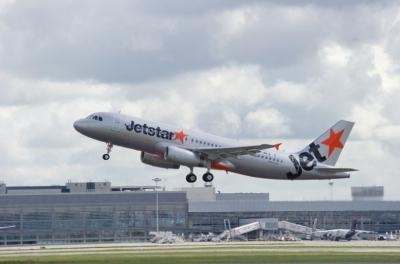Mistake Caused The Flight To Return To Auckland Airport
A clipboard left on the right engine cowling of a Jetstar Airways A320 by a ramp worker caused the flight return to the Auckland, NZ airport when the mistake was brought to the pilot's attention.

According to an ASTB report on the incident, on October 27, 2017 at about 1900 Coordinated Universal Time, the Jetstar Airways Airbus A320 aircraft, registered VH-VGY, was being prepared for a scheduled passenger service from Auckland International Airport, New Zealand to Sydney, Australia. The captain was designated as the pilot flying and the first officer was the pilot monitoring.
At about 1909, the leading hand had finished loading the last container into the aircraft hold and was organising his paperwork. As it was raining, he decided to put the clipboard in the right engine (No. 2) cowling to stop his paperwork from becoming wet and blown by the wind, with the intention to retrieve it later. The leading hand went to the flight deck, gave some paperwork to the flight crew, and returned to the ground to organize the aircraft’s push back.
At about 1919, the dispatcher cleared the ground and servicing equipment from the aircraft and conducted the ‘duty of care’ walk-around. During the walk-around, she noticed the clipboard in the right engine and thought that the leading hand would return for it, so she continued with the walkaround. Soon after, the engines reportedly started normally.
At about 1925, when the aircraft was taxiing, the leading hand realised his clipboard with the paperwork was missing and thought the dispatcher had the paperwork. The leading hand asked the dispatcher about the clipboard and she mentioned she saw it in the right engine during the walk-around. The ground crew returned to where they were preparing the aircraft and noticed paper debris on the ground. The ground crew organized for their operations area to contact the flight crew.
At about 1937, the aircraft departed. Shortly after, when on climb through flight level 150, the flight crew received a radio call from the Auckland Approach air traffic controller to contact the surface movement controller. The captain handed control of the aircraft to the first officer and contacted the surface movement controller who advised that the ground crew had lost their paperwork and it may have been placed on the engine. The captain requested further information about the paperwork, specifically whether the paper was on top of the engine or inside the inlet. The flight crew checked the engine instruments and there were no abnormal indications. The surface movement controller confirmed that the paperwork was placed within the inlet and paper debris was found on the tarmac. The captain then contacted the company engineer at the airport and asked whether it was just paperwork or a clipboard with a metal clip. The engineer advised that a piece of sheared metal had been found. The flight crew
decided to return to Auckland.

After landing at about 2048, the engine was inspected by engineers and paper was found throughout the engine. They also found minor damage to an engine fan blade and attrition liner.
The leading hand stated that, due to the wind and rain, he felt the need to shelter the paperwork. Normally, staff use the pushback tractor for shelter during adverse weather and to prepare paperwork for the flight. There is a metal box on the loader to store the folder. However, as the pushback tractor was not yet present at the bay, he used the engine cowling. He recalled that he did not feel pressured to rush the departure.
The dispatcher stated that she did not view the clipboard as a foreign object as it belonged to the leading hand and had the paperwork for the flight. She assumed that the leading hand would retrieve it later, prior to engine start-up.
The captain stated that, to obtain more information about the incident, numerous calls were made to other agencies, which took considerable time. Further, due to poor communications, he was unable to contact the operator’s maintenance controller to discuss the engine’s status.
The internal investigation into the incident by the ground handling operator, Aerocare, noted that the Jetstar Airways operational manual detailed the responsibilities of the dispatcher when conducting the ‘duty of care’ walk-around and provided a table of the steps involved for this process. While there was no specific requirement to check the engine cowlings/intakes for foreign objects, the manual stated that all staff operating near the aircraft were to be constantly observant for abnormalities and to report these to the leading hand or supervisor prior to the aircraft departing.
The investigation also noted that there was no procedure for the ground crew to establish communications with the flight crew in the event of a non-normal or emergency situation, either prior to or after the aircraft had departed. Further, there was no guidance on how paperwork was to be prepared and managed by ground crew during adverse weather conditions.
As a result of this incident, Jetstar Airways released an updated aircraft dispatch procedure, which included:
- a specific warning about not placing items in the engine cowling
- improved detail around checks and responsibilities
- a section on emergency and non-normal procedures
- detailing methods for re-establishing communications between ground crew and flight crew such as visually gaining the attention of the flight or contacting them via radio
(Image provided with ATSB report and from file)
 Unfortunate... ANN/SportPlane Resource Guide Adds To Cautionary Advisories
Unfortunate... ANN/SportPlane Resource Guide Adds To Cautionary Advisories ANN FAQ: Turn On Post Notifications
ANN FAQ: Turn On Post Notifications ANN's Daily Aero-Term (04.29.24): Visual Approach Slope Indicator (VASI)
ANN's Daily Aero-Term (04.29.24): Visual Approach Slope Indicator (VASI) ANN's Daily Aero-Term (04.28.24): Airport Marking Aids
ANN's Daily Aero-Term (04.28.24): Airport Marking Aids ANN's Daily Aero-Linx (04.28.24)
ANN's Daily Aero-Linx (04.28.24)




